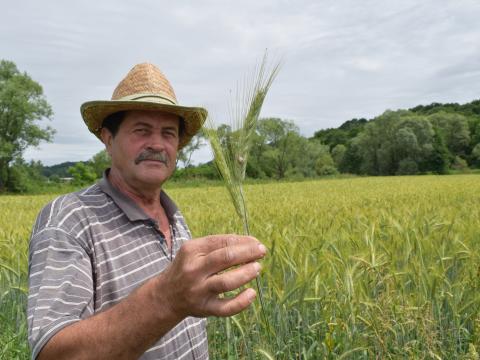Replanting hope in the flood plains of Bosnia and Herzegovina

Long lines of light grey clouds almost completely cover the sky above the small town of Srebrenik. The air is heavy and dry; giving the impression it is about to pour down at any minute.
“People here still live in fear of heavy rains“, says Senad Hasić, one of the inhabitants.
The deep fear stems back to three years ago when record-breaking floods, the worst in over a century, hit Bosnia and Herzegovina. The floods brought destruction to tens of thousands of households; killing animals, contaminating agricultural lands and calling into question the country’s food security, as well as the survival of thousands of families who earn their income from agriculture.
For the family of farmer Nihad Bajrektarević the damage was 100 per cent.
“The rain poured non-stop for days. No one ever witnessed anything like it” he remembers, taking a short break from work in front of his house. “Ah, and the barley that we planted that year…”
He doesn’t finish his sentence, but his wife quickly chimes in, touching her chest with her hand, “It hurts when I remember it”.
Although three years passed since the devastating floods, families can still feel the effects. Not only do the parts of the land move with the rainfalls, but the remaining land is harder to cultivate.
“Floods took away the large layer of fertile soil from the land“, explains Jovan, one of Nihad's neighbours, as he points to his piece of land next to the small creek.
In order to make the area cultivable again, World Vision cooperated with experts and conducted analysis of the agricultural land. After the analysis was done and based on the recommendations received, fertiliser was distributed to fifty families affected by floods. This was done as part of the project ‘Local Level Action for Sustainable Recovery’, which aims to support the sustainable recovery of flood-affected local communities in Bosnia and Herzegovina. Financed by the European Union, the project benefits five municipalities inhabited by 180,000 citizens.
Nihad and Jovan’s families were amongst those who received fertiliser to rehabilitate their soil. “Look at this wheat”, Jovan says as he picks two healthy green plants and holds them between his fingers. “You can see that we used the fertiliser and it’s good.”
Thanks to the help received, Jovan and Nihad’s lands are becoming green again. But, for many other areas, destruction is still visible. “To this day today, we still have areas that cannot be cultivated. There are lands that completely disappeared with the floods and some of the most fertile areas have been put out of production“, explains Senad Hasić, also an employee of Srebrenik Municipality, summarising the situation as “still not where we were before 2014“.
Distribution of fertiliser as a way of rehabilitating the soil is one of the several environmental and economic interventions envisaged according to the specific local needs of the communities participating in the project. Other activities included: reforestation, clearance of drainage channels and minor watercourses, clearing of beds and banks along minor watercourses and rehabilitation of landslides.
“In addition to this, networks for flood risk reduction will be established at local levels, where World Vision will educate relevant local stakeholders so that they have capacities, knowledge and skills to respond effectively to possible disasters in the future”, says Almir Zulić, World Vision’s Livelihood and Resilience Program Manager.
With this holistic approach to sustainable recovery, the hope is that, in the case of possible future emergencies, the communities will be able to mitigate possible risks making them safer for all their inhabitants.
